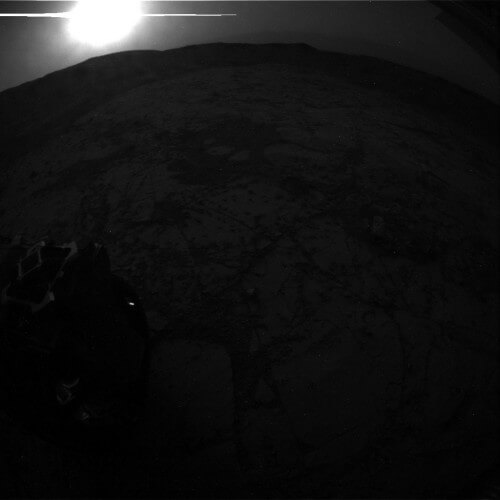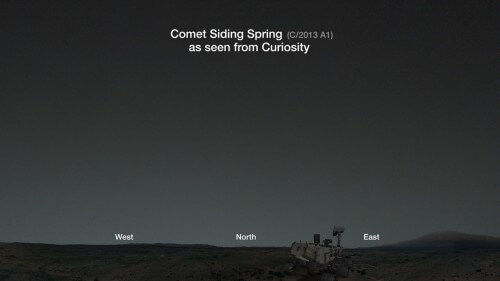Until more details come from NASA, the European Space Agency Mars Express is working well, first images of the comet's halo soon.

Comet Siding Spring made a relatively close pass this evening about 130 thousand km from the surface of Mars. NASA has released the first raw image of the comet Siding Spring from the ground of Mars. This black and white image mainly shows the night ground in the vicinity of the robotic vehicle, and a section of the sky where you can see a spot of bright light - the comet's halo.
Now scientists and astronomy enthusiasts from all over the world are waiting for more and more detailed images as well as an answer to the question of whether this transit created a low-altitude meteor shower on Mars.
While writing lines we are watching the live broadcast of the European Space Agency from the control room of the Mars Express spacecraft.
The operations manager of the Mars Express spacecraft, Michel Dennis, commented on the state of the spacecraft: "When the comet was discovered about a year ago, we thought about what to do, without endangering the spacecraft. We came to the conclusion that the halo and the tail of the comet could damage the spacecraft. We decided to prepare for the worst, so for example we rotated the solar collectors in parallel with the movement of the dust particles from the comet's tail so that they would not be damaged. This harmed the spacecraft's scientific capability. Nevertheless we directed it to a comet and the atmosphere of Mars. As it appears now (an hour after the passage) the spacecraft successfully survived the stream of dust and gas particles from the comet."
Andy Johnson, the team manager of Mars Express, who has been preparing for a year and a half the actions that Mars Express will do during the meeting. Initially, we believed that the risk to the spaceship, like the risk to the spaceships of NASA and the Indian Space Agency, would be much greater. The fear was of physical damage, damage mainly to the solar collectors. But there are other sensitive areas such as the spacecraft's computer and scientific instruments
.
Simon Wood, one of the members of the scientific team of Mars Express: "Today is the big day from the scientific aspect. We have been watching the comet every day for the past few weeks. Especially with the high resolution camera, and in the infrared field. The other instruments, especially the radar, observe Mars during these hours, to examine the effect of the dust particles from the comet's tail on the Martian atmosphere, as well as the instrument that usually examines the solar wind, this time examining the mutual reaction between the comet's tail and its halo and the Martian atmosphere."
Recently, the European Space Agency marked the tenth anniversary of the operation of the Mars Express spacecraft in orbit around Mars and detailed the achievements of Mars Express in the decade it has been in space: among the achievements we can mention the first image we received, the first measurement of water in the polar ice cap. As for the atmosphere, we contributed to the debate about the existence of methane in the atmosphere, but the answer to that will await Exo Mars - the next spacecraft that the European Space Agency will launch to Mars in 2016."\
The science site will continue to update scientific news in the morning hours.

Previous articles on the subject:

One response
Opportunity didn't take a picture?